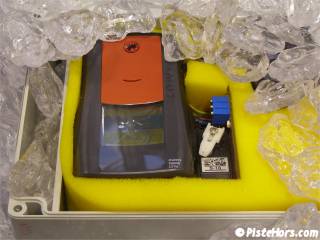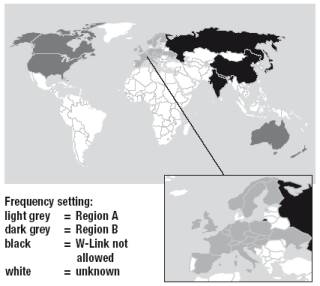
Gear > Avalanche Gear > Avalanche Transceivers > Digital Beacons > Mammut Pulse
Mammut were demonstrating the Pulse at the Munich ISPO, it looks more like a personal organizer than a beacon. The Pulse comes in a rugged and small black and red box with a large dot-matrix display. Andres Lietha, head of marketing, says this has the advantage that they can display what they like in this area allowing for upgrades to software without altering the hardware. We asked about the problems with cold and LCD displays and Mammut assures us that this is not an issue with the latest displays and that the Pulse has been tested in a wide range of temperatures. The display is visible under bright light and protected by an additional plastic screen.

The Pulse has an easy to use slider switch which can lock the beacon into Send, Receive and Off. The case is shock resistant and waterproof. The off button did not appear to be integrated with the harness, although this was a demo model and was not supplied with a harness. The beacon is controlled by large buttons on either side, these could be operated with gloves on.
When the Pulse boots up into receive mode there is a short delay then a personalized message is displayed. The beacon analyzes all the signals within range displaying information about each victim. This is where the Pulse bit comes in, if the victim is also wearing a Pulse beacon it will detect small chest movements and display on the searchers beacon if vital signs are being received (shown by a heart symbol). It will also show if other users within range are already searching for the victim (shown by a square box). A searcher can then decide whether to go for live victims or use the Easy Search mode to select the nearest available victim. This feature will no doubt spark debate about how much information should be displayed during a search. It certainly makes sense to dig out live victims, they may even be able to help with the search for others. Some professionals we spoke to were against searchers having too much, perhaps unreliable information about buried victims. If the beacon has shifted during the slide or if the victim is wearing another type of beacon no vital signs are shown.
The searcher scrolls through the list of victims, the distance and direction to each is shown. Once a victim is selected a 360º compass type arrow is displayed indicating the shortest direction to the victim. If the searcher is heading the wrong way along the flux line this is evident. The addition of the third antenna means that distance and depth information are more accurate no matter what the orientation of the victim. Within three meters of the victim the display switches to a crosshair mode giving the direction the beacon should be moved over the surface of the avalanche debris in order to pinpoint the victim. Once the victim has been confirmed by a probe the searcher can mark the subject. The Pulse will display a cross symbol in the victims information and will select the next nearest victim. It will also communicate with other Pulse beacons within range to show that this victim has been found.

The Pulse really comes into its own where all members of a party are wearing the same beacon as is the case for guided groups or professionals. If the Pulse gains enough market share the search protocol may be adopted by other beacon makers. Within the limited confines of the Mammut stand the Pulse certainly performed as claimed and made multi-victim searches almost a no-brainer. The engineers from Mammuts R&D company Ascom say that some finalization of the software is still required but the beacon should be ready for production by the end of the summer. Obviously software reliability is a major concern, most people have experienced crashes with their mobile phone or pocket PC. Ascom say that the software in the Pulse is extremely reliable and if a crash does occur the Pulse will automatically reboot. Like the older Opto 3000 the Pulse will also switch back into transmit mode if there is no activity, for example if the searcher is caught in a secondary avalanche.
Pricing is expected to be 329 in Europe, $400 in the US
Note the vital signs data is transmitted on a separate frequency which varies depending on location. Beacons sold into the North American market are not compatible with those sold in Europe for this function. The vital signs functionality is disabled for Asia. It is possible to reprogramme this feature if you are moving from one area to another. This is possible through the menu system for European sourced beacons but this is a factory service option for US beacons which may be something to consider if you are going to be travelling a lot from the US to Europe (buy a European spec Pulse). Obviously this won't affect a group travelling to Europe with say all beacons purchased in the US.

Note this limitation in no way affects the general search functions of this beacon.
If you've tried the Mammut Pulse, login or register and write up your experiences here.
<< Barryvox Opto 3000 | Digital Beacons | Tracker DTS >>